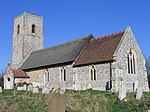Carleton St Peter

Carleton St Peter is a hamlet and civil parish in South Norfolk approximately 8+1⁄2 miles (13.7 km) south-east of Norwich. There is no village centre but the church provides a reference point and is 1 mile (1.6 km) north-east of Thurton, and a similar distance south of Claxton, just east of Ashby St Mary. In the 2001 census Carleton St Peter contained just 15 households and a population of 29 spread across the 3.19 km2 (1.23 sq mi) of the parish. The church cannot be reached by road and sits in a small graveyard in the middle of a field reached by a short path between ploughed fields. The tower contains four bells but they cannot be rung.The parish extends northwards to include the Beauchamp Arms public house on the south bank of the River Yare and the nearby Buckenham Sailing Club. These lie at the end of Ferry Road although the ferry across to Buckenham on the north bank stopped running before World War II. Between Carleton St Peter and Claxton, on the banks of Carleton Beck, lies Ducan's Marsh, a Site of Special Scientific Interest and one of the richest areas of unimproved wet grassland in East Norfolk.
Excerpt from the Wikipedia article Carleton St Peter (License: CC BY-SA 3.0, Authors, Images).Carleton St Peter
Spong Lane, South Norfolk Carleton St. Peter
Geographical coordinates (GPS) Address Nearby Places Show on map
Geographical coordinates (GPS)
| Latitude | Longitude |
|---|---|
| N 52.566021 ° | E 1.449852 ° |
Address
Spong Lane
Spong Lane
NR14 7BD South Norfolk, Carleton St. Peter
England, United Kingdom
Open on Google Maps








